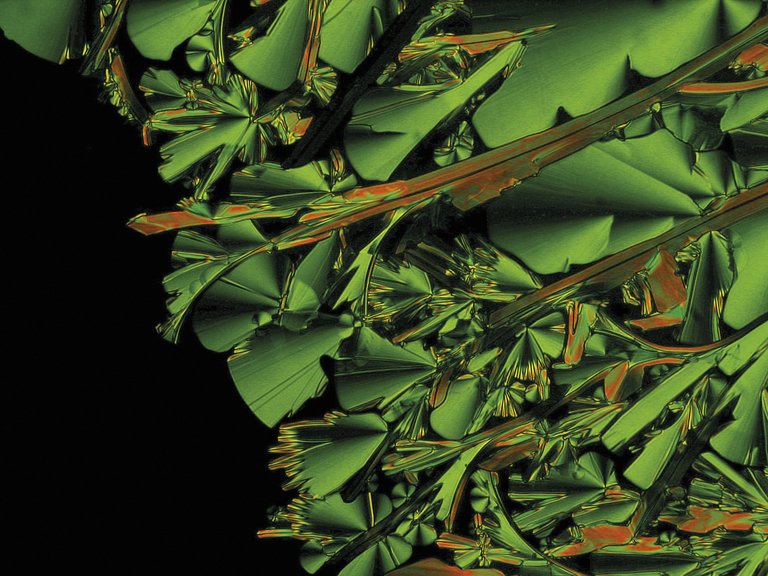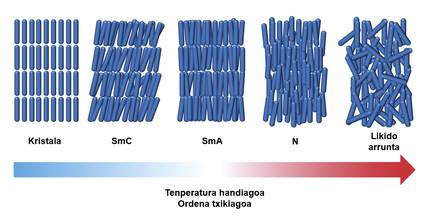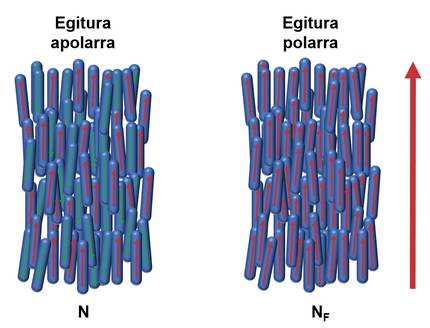Liquid crystals: towards a deeper understanding of matter
There are substances in nature that have characteristics between solids and liquids: liquid crystals. In addition to being intensely interesting from a scientific point of view, they are also key in today’s technology. Recently, a new type of liquid crystal has been discovered that has broken the schematics of scientists. It is a matter of long history and the adventure of understanding its physics continues.

What are the states of aggregation of matter? If you ask this question to a high school student, the answer would probably be: solid state, liquid state, and gas state. Maybe some smart kid knows what plasmas are, too. In reality, if the temperature of a substance rises, it is possible to remove electrons from its atoms and bring them to a new phase. This new state is called plasma, and we take advantage of it in everyday life, such as fluorescent tubes. However, there is another particular situation that will probably be completely unknown to the reader, although it is present in some daily devices: liquid crystal.
In the simplest case they are substances composed of rod-shaped molecules. While these compounds are fluid, the interactions between the molecules cause them to orient parallel to each other. Because of this additional order that ordinary liquids do not have, they were called liquid crystals [1]. What are liquid crystals used for? For flat screens, for example. In fact, the molecules of these materials are usually polar and, assisted by their fluidity, can easily be oriented by means of electric fields. Thus, if placed between two light polarizers, they can pass or block light.
Aside from the technological complexities, this is basically how LCDs (Liquid Crystal Display) work. Although organic diode based OLED technology has been widely deployed in recent years, the LCD industry still has a significant weight. Also, due to the potential usefulness of liquid crystals in photonics [2], it remains a living research area.

Since the discovery of the first liquid crystal in the nineteenth century, several sub-phases have been observed in the compounds that have been synthesized over the years, which are classified according to the structure that the molecules adopt. The above-mentioned nematic liquid crystals (represented by N) have only the order of orientation. However, the smectic liquid crystals (Sm) also have a positional order. This is because, in addition to orienting the molecules in a certain direction, they tend to lie in planes parallel to each other, always maintaining a certain fluidity. At the beginning of the 20th century, the famous physicists Debye and Born proposed to you the existence of a new phase [3, 4]: ferroelectric nematic liquid crystal (NF). Although the molecules of common nematic materials are polar, the entire structure is apolar. That is, not all electric dipoles (separation of positive and negative charges) need to be oriented in the same direction, since molecular interactions do not separate the ends of the molecules [5]. The ferroelectric nematic phase would be polar, i.e. all dipoles would be oriented in one direction. Decades and decades passed after this theoretical prediction, but no material was found to show this phase. The only ferroelectric liquid crystals that were synthesized were smectic, as the order of position of the molecules was said to favor the appearance of ferroelectricity. The sterile thorn up to this point led scientists to conclude that fluidity (small order of position) and ferroelectricity are mutually exclusive [6]. In fact, thermal agitation would be able to eliminate even the slightest long-range dipole ordering that might occur in the material. According to this statement, it was therefore not surprising that no such material had been found.

but in 2017, some chemists synthesized some strange compounds [7, 8]. The molecules of these materials were highly polar and a nematic phase transition was observed when the temperature was lowered. In any case, the nature of the low-quality nematic phase was negligible. A research group studied the structure of one of these liquid crystals (called RM734) [9]. The researchers proposed that the RM734 complex leads to a locally polar nematic phase. It would contain alternating polar domains in which the molecules would adopt a splay structure, i.e. the molecules would extend radially from an origin. Although this structure was later found to correspond to another intermediate phase between the N and NF phases, this preliminary investigation was important. In any case, scientists from the University of Colorado's Soft Materials Research Centre were the first to test the ferroelectricity of this plant in 2020 [10]. According to the Americans, this liquid crystal shows the NF phase predicted by Born, which has macroscopic polar domains. These results have been corroborated by so many groups around the world, and a number of molecules have been found to meet similar standards. We can therefore say that a new state of matter has been discovered.
The challenge now facing scientists is to understand this new phase. What are the characteristics of the NF phase? What are the molecular mechanisms that allow dipole pairing? We ourselves, as researchers in the Department of Physics of the University of the Basque Country, are trying to answer these questions. To do this, we use electrical methods. In particular, we measure the so-called dielectric permittivity, both as a function of the frequency of electrical excitation and as a function of temperature. This physical magnitude in some way quantifies the effect of an external electric field on a given surface. Although this variable is macroscopic, a proper analysis of the data makes it possible to investigate the molecular processes of these materials. In the NF phase, in particular, the gigantic values of dielectric permittivity have been measured [11]; their origin, however, is unknown. By asking these questions, we will have a better understanding of the nature of this mixed phase. In addition, the interest of these materials is not only scientific, but also technological. Indeed, NF modules could be useful for more efficient displays, new electro-optical devices, etc. In short, it should be noted that these compounds are characterised by their polarity, i.e. they are very sensitive to external electric fields. As a result, it would not be surprising that in a few years we all carry an NF material on our mobile phones.
The bibliography
Acknowledgements
Aitor Erkoreka would like to thank the Department of Education of the Basque Government for the grant received through the Pre-Doctoral Programme for the Training of Non-Dodecessor Researchers.
Buletina
Bidali zure helbide elektronikoa eta jaso asteroko buletina zure sarrera-ontzian











